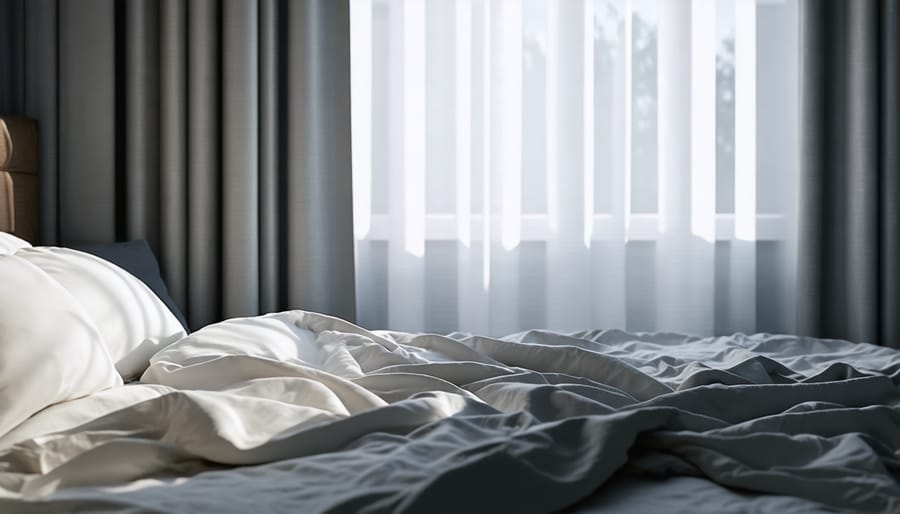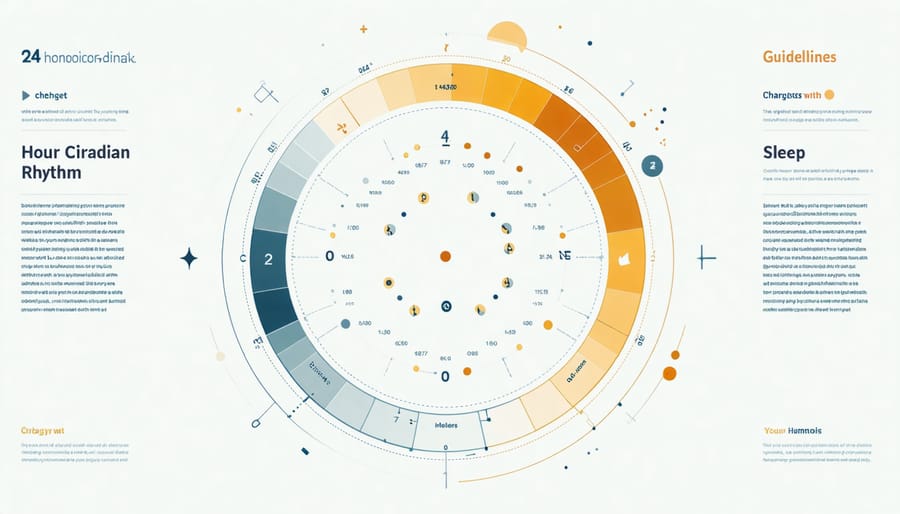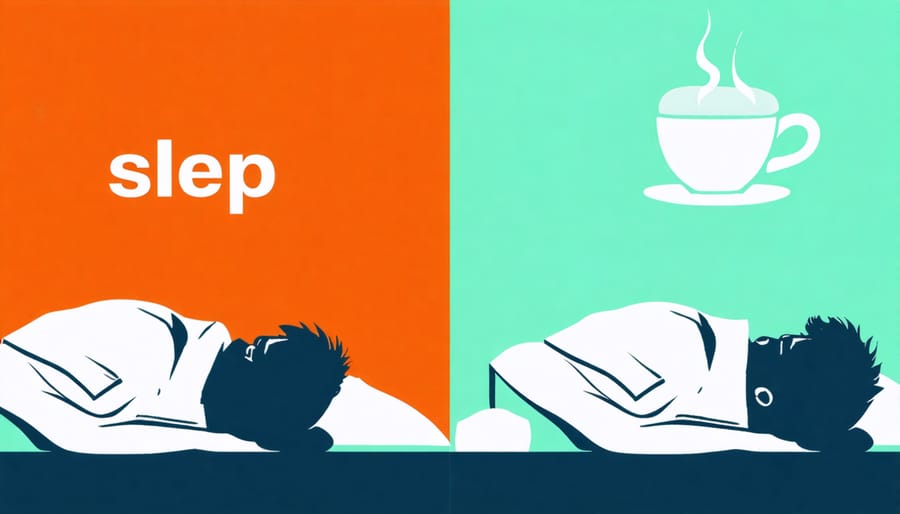Transform your bedroom into a sleep sanctuary by maintaining a consistent temperature of 18-20°C (65-68°F), eliminating all sources of blue light, and using blackout curtains to create complete darkness. Establish a non-negotiable sleep schedule that aligns with your natural circadian rhythm, going to bed and waking up at the same time every day – even on weekends. Reset your body’s sleep-wake cycle by exposing yourself to bright natural light within 30 minutes of waking and gradually dimming indoor lights two hours before bedtime.
Quality sleep directly impacts everything from cognitive function and emotional resilience to physical recovery and immune system strength. Research shows that adults who consistently get 7-9 hours of uninterrupted sleep experience better weight management, reduced inflammation, and enhanced memory consolidation. Modern sleep science reveals that optimizing your sleep environment and pre-bedtime routine can improve sleep quality by up to 60%.
Strategic adjustments to your lifestyle, including limiting caffeine intake after 2 PM, practicing a 10-minute mindfulness routine before bed, and investing in a supportive mattress that matches your sleeping position, create the foundation for restorative sleep that energizes both body and mind.
The Perfect Sleep Environment

Temperature and Lighting Control
Creating the right sleep environment through proper temperature and lighting control is one of the most crucial environmental factors affecting sleep. Research shows that the ideal bedroom temperature for optimal sleep falls between 18-20°C (64-68°F). This range helps maintain your body’s natural temperature regulation during sleep cycles.
To achieve this optimal temperature, consider using a programmable thermostat that automatically adjusts to cooler temperatures at night. During Canadian winters, avoid overheating your bedroom, as excessive warmth can disrupt sleep quality. In summer months, use light breathable bedding and consider using a fan to maintain air circulation.
Lighting plays an equally important role in regulating your sleep-wake cycle. Your body’s circadian rhythm responds strongly to light exposure, particularly blue light. To optimize your sleep environment:
– Use blackout curtains or blinds to create complete darkness during sleep hours
– Install dimmer switches to gradually decrease light exposure before bedtime
– Use warm, low-wattage bulbs in bedside lamps
– Remove or cover electronic devices that emit light
– Consider using a dawn simulator alarm clock to wake up naturally
In the hours before bedtime, reduce exposure to bright screens and overhead lighting. This helps your body produce melatonin, the hormone responsible for regulating sleep. If you need to get up during the night, use night lights with red bulbs, as red light is less disruptive to your sleep cycle.
Sound Management and Sleep Technology
Managing sound in your sleep environment is crucial for quality rest. White noise machines can effectively mask disruptive sounds and create a consistent audio backdrop that promotes better sleep. These devices offer various sound options, from rainfall to ocean waves, helping you find the perfect audio environment for your needs.
For those living in noisy urban areas, earplugs are a simple yet effective solution. Look for comfortable, high-quality options rated at 25-33 decibels for optimal noise reduction without completely blocking important sounds like alarm clocks.
Smart sleep technology has revolutionized how we monitor and improve our rest. Sleep tracking apps and wearable devices can provide valuable insights into your sleep patterns, including sleep stages, duration, and quality. This data helps you make informed adjustments to your sleep routine.
Sound-blocking curtains and door sweeps can significantly reduce external noise. For apartment dwellers, consider placing foam panels on shared walls to minimize noise transfer from neighbours.
Many modern smartphones and tablets now include built-in features like wind-down modes and blue light filters. These tools automatically adjust your device’s settings as bedtime approaches, helping your body prepare naturally for sleep.
Remember that technology should support, not disturb, your sleep. Keep devices at least one metre from your bed and use “do not disturb” settings during sleep hours to prevent notifications from interrupting your rest.
Timing Your Sleep for Maximum Benefits
Your Body’s Natural Sleep Rhythm
Your body operates on a natural 24-hour cycle known as the circadian rhythm, which plays a crucial role in regulating your sleep patterns. This internal clock responds primarily to light and darkness, helping your body know when to feel alert and when to feel sleepy.
During daylight hours, your body produces cortisol to keep you energized and alert. As evening approaches and natural light diminishes, your brain begins producing melatonin, the hormone responsible for making you feel drowsy. This natural process typically starts around 9 PM for most people, signaling that it’s time to wind down.
Understanding your personal sleep-wake cycle can help you optimize your rest. Most adults experience their deepest sleep between 2 AM and 4 AM, with natural awakening occurring as cortisol levels rise again in the early morning hours. This pattern explains why maintaining consistent sleep and wake times is so important – it helps your body predict and prepare for rest.
Your body temperature also fluctuates throughout the day as part of this rhythm. It peaks in the late afternoon and drops in the evening, reaching its lowest point in the early morning hours. This natural cooling helps promote better sleep, which is why sleep experts recommend keeping your bedroom cool.
Working with your body’s natural rhythm rather than against it can significantly improve your sleep quality. Try to expose yourself to natural light during the day, begin dimming lights in the evening, and maintain regular sleep and wake times – even on weekends. These simple adjustments can help align your daily activities with your body’s natural sleep-wake cycle, leading to more restful nights and energized days.

Strategic Napping
Strategic napping can be a powerful tool for boosting energy and productivity when done correctly. The key is to time your naps appropriately to avoid interfering with your nighttime sleep schedule. The ideal nap duration falls between 10 to 20 minutes, commonly known as a “power nap.” This length provides refreshment without causing sleep inertia – that groggy feeling you get when waking from deeper sleep.
The best time to nap is during the early afternoon, typically between 1:00 PM and 3:00 PM, when our natural circadian rhythms create a slight dip in energy. Avoid napping after 4:00 PM, as this can make it harder to fall asleep at night.
To make the most of your nap:
– Find a quiet, dimly lit space
– Set an alarm to avoid oversleeping
– Use a light blanket (body temperature drops during sleep)
– Try to nap in a seated position to prevent falling into deep sleep
For shift workers or those with irregular schedules, the “coffee nap” technique can be particularly effective. Drink a cup of coffee immediately before taking a 15-20 minute nap. The caffeine kicks in just as you wake, maximizing alertness.
Remember that while napping can be beneficial, it shouldn’t be used as a substitute for proper nighttime sleep. If you find yourself needing long naps regularly, this might indicate poor sleep quality or insufficient nighttime rest. In such cases, focus on improving your primary sleep schedule before incorporating strategic naps into your routine.

Pre-Sleep Routines That Work
Digital Detox and Relaxation Techniques
In today’s digital age, the blue light emitted from our screens can significantly disrupt our natural sleep patterns. Establishing a digital curfew at least one hour before bedtime allows your brain to produce melatonin naturally, helping you fall asleep more easily. Consider using blue light filtering apps or glasses if you must use devices in the evening.
Creating a relaxing pre-bed routine is essential for quality sleep. Simple relaxation techniques like deep breathing exercises, gentle stretching, or progressive muscle relaxation can help transition your mind and body from daily stress to a state of calm. Try the 4-7-8 breathing method: inhale for 4 seconds, hold for 7 seconds, and exhale for 8 seconds.
To make your digital detox more effective, keep all devices out of the bedroom. Instead of scrolling through social media or checking emails, consider calming activities like reading a physical book, journaling, or listening to soft music. If you use your phone as an alarm, invest in a traditional alarm clock to eliminate the temptation of late-night screen time.
Remember to gradually reduce screen exposure throughout the evening. Start dimming lights and switching to warmer color temperatures about two hours before bed. This gentle transition helps your body recognize that it’s time to wind down, making it easier to fall asleep when you finally turn in for the night.
Nutrition and Exercise Timing
The timing of your meals and exercise plays a crucial role in achieving quality sleep. Making smart food choices for better sleep starts with avoiding heavy meals within three hours of bedtime. This allows your digestive system to settle and prevents discomfort that might interrupt your rest.
Consider having your last substantial meal 4-5 hours before bed. If you need a light snack closer to bedtime, opt for sleep-promoting combinations like whole grain crackers with cheese, a small bowl of oatmeal, or a banana with a tablespoon of almond butter. These choices provide a balanced mix of complex carbohydrates and proteins that support peaceful sleep.
As for exercise timing, aim to complete vigorous workouts at least 3-4 hours before bedtime. While regular physical activity improves sleep quality, intense evening exercise can elevate body temperature and stimulate the release of endorphins, making it harder to wind down. However, gentle stretching or yoga in the evening can help prepare your body for rest.
Hydration timing matters too. Try to consume most of your daily water intake earlier in the day, tapering off in the evening to minimize nighttime bathroom visits. If you enjoy caffeine, limit its consumption to the morning hours, as its effects can last up to 8 hours in some people. Remember that certain teas, chocolate, and sodas also contain caffeine, so be mindful of these sources later in the day.
Addressing Common Sleep Disruptors
Stress Management
Managing stress is crucial for quality sleep, as stress-related sleep issues can create a challenging cycle that affects both mental and physical well-being. Start by establishing a calming bedtime routine that includes gentle stretching or light yoga poses. Deep breathing exercises, particularly the 4-7-8 technique (inhale for 4 seconds, hold for 7, exhale for 8), can help activate your body’s relaxation response.
Consider keeping a worry journal beside your bed to jot down concerns before sleep, effectively “parking” them for the next day. Mindfulness meditation, even for just 5-10 minutes before bed, can help quiet racing thoughts. Creating boundaries with work-related communications and setting a digital curfew an hour before bedtime can significantly reduce evening stress levels.
Regular physical activity during the day naturally reduces stress hormones, but avoid intense exercise close to bedtime. If stress persists, try progressive muscle relaxation, starting from your toes and working up to your head, tensing and releasing each muscle group.
Managing Sleep Schedule Changes
Adapting to changes in your sleep schedule, whether due to shift work or travel, requires careful planning and consistent strategies. When facing shift work challenges, gradually adjust your sleep timing by 15-30 minutes each day until you reach your target schedule. Create a dark, quiet sleeping environment during daylight hours using blackout curtains and white noise machines to simulate nighttime conditions.
For managing jet lag, begin adjusting your sleep schedule a few days before travel by shifting your bedtime closer to your destination’s time zone. During long flights, stay hydrated and try to sleep if it’s nighttime at your destination. Upon arrival, expose yourself to natural daylight during local daytime hours to help reset your internal clock.
Maintain regular meal times aligned with your new schedule, as this helps regulate your body’s circadian rhythm. Avoid caffeine at least 6 hours before your planned sleep time, and consider using melatonin supplements as directed by your healthcare provider. Remember that it typically takes one day per time zone crossed to fully adjust to a new schedule, so be patient with your body’s adaptation process.
Implementing better sleep habits is a journey that begins with small, manageable steps. By focusing on creating an optimal sleep environment, maintaining consistent bedtime routines, and practicing healthy sleep hygiene, you can significantly improve your sleep quality. Remember that everyone’s sleep needs are unique, so feel free to adapt these solutions to fit your lifestyle and preferences. Start by choosing one or two changes to implement this week, then gradually incorporate more as these become habits. Quality sleep is a cornerstone of good health, affecting everything from mental clarity to physical recovery. Your investment in better sleep today will pay dividends in improved health, enhanced mood, and increased energy tomorrow. Make sleep a priority in your wellness journey, and you’ll be well on your way to a more vibrant, healthy life.

